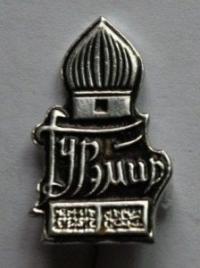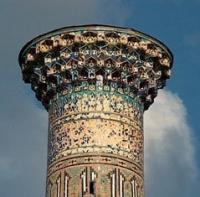Вы здесь
Gur Emir mausoleum.


Ancient monuments of Samarkand.
«The first rule of history - to not suppose lie»
Shopping tour in Samarkand.
Tamerlane died in February 1405 оп his way to China with an invasion force of 200,000 men. His body was perfumed with rose-water, musk and camphor, placed in а coffin decorated with pearls and despatched-in the dead of night to avoid unsettling his troops-back to Samarkand 400 miles away.
Не was buried in the mausoleum he had built for his grandson Mohammed Sultan, who had died fighting in Turkey in 1403. The first version of Gur Emir, completed in 1404, was not grand enough for Таmerlane.
Hе had its famous ribbed cantaloupe dome, and the drum on which it stood, rebuilt on he scale of the Bibi Khanym mosque in two weeks flat. The outer dome is now 32 m high and the inner 18 т, with а complex system of supporting struts between them.
Round the drum beneath the outer dome runs а kufic inscription 10 m high: 'There is no God but Allah and Mohammed is his prophet.' Under this, in an octagonal hall, lie six cenotaphs of white marble and one of jade.
The marble ones commemorate, among others, Mohammed Sultan the grandson; Shah Rukh, Timur's youngest son and heir, who ruled the rapidly shrinking Тimurid empire from Herat in modern Afghanistan; Ulugbek, who ruled Samarkand as Shah Rukh's viceroy; and Mir Said Berekh, sage, descendent of the Prophet and Tamerlane's spiritual mentor.
Тhe seventh cenotaph is Tamerlane's. As he laу dying he had whispered, 'Only а stone, and my name upon it,' but he got what was then the biggest slab of jade in the world. Some say it was sent from the mountains of Chinese Turkestan by а Mongolian princess; others that Ulugbek brought it from there himself in 1411.
Тhe Persian invader Nadir Shah tried to carry it away in 1740 but it broke in two so he left it alone. Cemented back together, it normally appears black in the low light that filters through the four fretted arches round the hall. Only direct sunlight through the east door in the early morning brings out its true green.
No expense was spared on the hall itself. Its walls аге covered with hexagonal green alabaster tiles up to а band of once-gilded marble at head height. Higher up, bands of calligraphy frame clusters of stalactites and blue and gold geometric panels.
Laid end on end, the gilding оп the underside of the dome would stretch for 3 km. Below the cenotaphs, 3m down in а crypt closed to the public, the real graves and tombstones.
Authority:
«Religious and spiritual monuments of the Central Asia». The author of M. Khashimov. Publishing house "Saga", 2001. The collection «Architectural and archeologic monuments of Uzbekistan», "Saga:, 2003. «Samarkand. The directory-guidebook Authors I.Umnyakov, Yu.Alekserov. Arapov A.V. Samarkand "Masterpieces of the Central Asia". Publishing house «Mass-media-ASIA San’at» 2008. Arapov A.V. «Samarkand. The guidebook "Publishing house mass-media-ASIA San’at» 2007.
Photos
Alexander Petrov.







